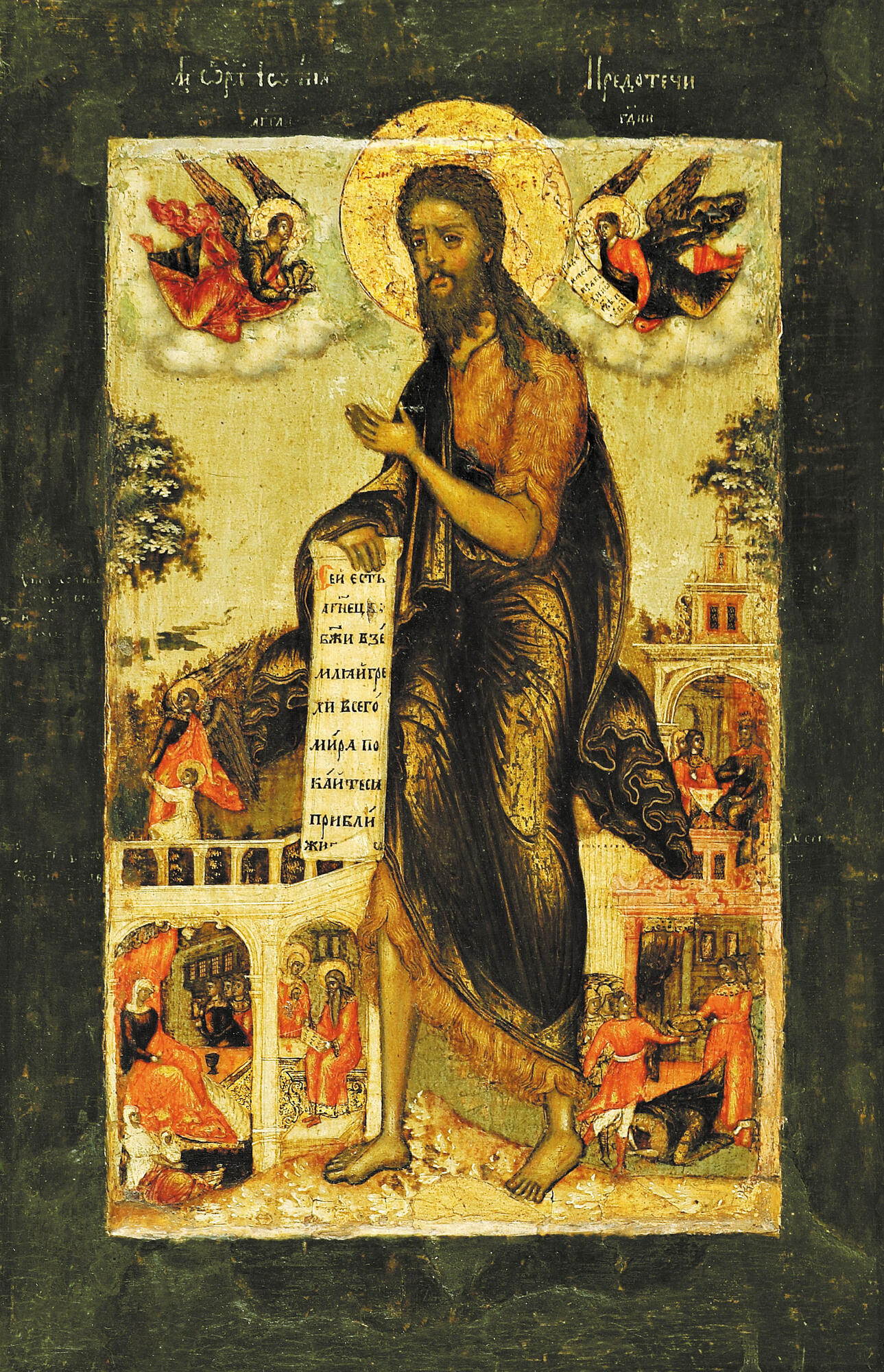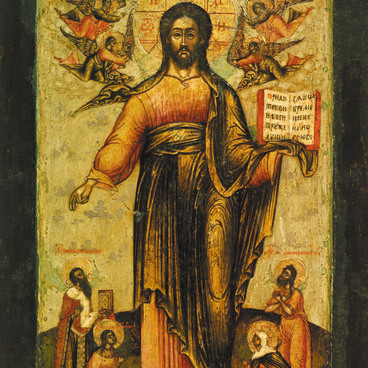The Orthodox icon painting tradition features a variety of images of John the Baptist who is sometimes referred to as the most important person after the Virgin Mary. This icon used to belong to a small Deesis row of three icons which were most likely created for praying at home. The scroll features a quote from the Gospel of John (1:29): “Behold the Lamb of God, which taketh away the sin of the world.”
The central image of John the Baptist is complemented by four border scenes which are to be read in a clockwise manner starting from the bottom left one: “the Nativity of John the Baptist”, “the Angel Leads the Young John to the Desert”, “the Feast of Herod”, and “the Beheading of Saint John the Baptist”.
The Nativity of John was described by Saint Luke. John’s parents, the priest named Zacharias and the righteous Elizabeth, were childless until a very advanced age. According to Jewish traditions, this could be interpreted as a curse inflicted on them for their sins. However, God answered their prayers and gave them a child. Archangel Gabriel appeared to Zacharias and brought him the tidings of great joy. He announced that the couple would have a son who “shall be great in the sight of the Lord… and shall be filled with the Holy Ghost, even from his mother’s womb” (Luke 1:13–17). Zacharias could not believe that, and for his doubt, he was struck dumb. When the days of his ministry were complete, Zacharias returned to his house, and Elizabeth became pregnant with a son. According to the tradition, the newborn child was supposed to be named after his son, and the relatives who gathered in the house were astonished to find out that it had been decided otherwise. Zacharias, still unable to speak, wrote down, “His name is John, ” and his tongue was set free (the first scene).
There is little information about John’s childhood in the Gospels. It is known only that John the Baptist appeared before people at the age of thirty. Before that, he had lived as an ascetic in the desert. It is mentioned in the Apocrypha that, having found out about Herod’s order to execute children, Elizabeth escaped to the desert together with her son. Zacharias was murdered by Herod’s soldiers for refusing to divulge their whereabouts. In the desert, John started getting ready for his preaching (this is indicated by the second scene where John is led by an angel).
The Feast of Herod (the third scene) precedes the execution of John the Baptist. This was where Salome, the daughter of Herodias, danced before her stepfather Herod and asked for John’s head as a reward for her dance. The fulfillment of her wish is portrayed in the fourth border scene.
Similar images were usually kept at home. The scenes of John’s childhood are considered to be the example of righteous and virtuous parenthood.
The central image of John the Baptist is complemented by four border scenes which are to be read in a clockwise manner starting from the bottom left one: “the Nativity of John the Baptist”, “the Angel Leads the Young John to the Desert”, “the Feast of Herod”, and “the Beheading of Saint John the Baptist”.
The Nativity of John was described by Saint Luke. John’s parents, the priest named Zacharias and the righteous Elizabeth, were childless until a very advanced age. According to Jewish traditions, this could be interpreted as a curse inflicted on them for their sins. However, God answered their prayers and gave them a child. Archangel Gabriel appeared to Zacharias and brought him the tidings of great joy. He announced that the couple would have a son who “shall be great in the sight of the Lord… and shall be filled with the Holy Ghost, even from his mother’s womb” (Luke 1:13–17). Zacharias could not believe that, and for his doubt, he was struck dumb. When the days of his ministry were complete, Zacharias returned to his house, and Elizabeth became pregnant with a son. According to the tradition, the newborn child was supposed to be named after his son, and the relatives who gathered in the house were astonished to find out that it had been decided otherwise. Zacharias, still unable to speak, wrote down, “His name is John, ” and his tongue was set free (the first scene).
There is little information about John’s childhood in the Gospels. It is known only that John the Baptist appeared before people at the age of thirty. Before that, he had lived as an ascetic in the desert. It is mentioned in the Apocrypha that, having found out about Herod’s order to execute children, Elizabeth escaped to the desert together with her son. Zacharias was murdered by Herod’s soldiers for refusing to divulge their whereabouts. In the desert, John started getting ready for his preaching (this is indicated by the second scene where John is led by an angel).
The Feast of Herod (the third scene) precedes the execution of John the Baptist. This was where Salome, the daughter of Herodias, danced before her stepfather Herod and asked for John’s head as a reward for her dance. The fulfillment of her wish is portrayed in the fourth border scene.
Similar images were usually kept at home. The scenes of John’s childhood are considered to be the example of righteous and virtuous parenthood.



